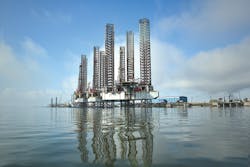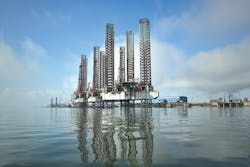A Win-Win Proposition for Refiners and Municipalities
By Nick Johnson
Water has traditionally been a low-cost utility, one that required little thought or optimization as to the source. But our changing water landscape has begun to bring this vital resource to the forefront.
Refiners depend immensely on water for heating, cooling and other processes, and access to an abundant, secure and cost-effective water source is critical to maintaining reliable and profitable operation. However, with water stress becoming more widespread and water rates on the rise, questions regarding the viability of traditional water sources have begun to arise for some refiners, either due to cost, availability or a bevy of other factors. In response, many have begun to examine the use of alternative water sources, few of which have proven more promising than treated municipal wastewater.
With its consistent quality and relative abundance, municipal secondary effluent is an attractive alternative water source for refiners, particularly for those in densely populated areas. Human activity necessitates that wastewater will always be in supply, and the high quality of the treated wastewater makes it a prime source for further treatment to be used as cooling water, boiler feedwater or as general utility water. But while the use of municipal wastewater effluent as a sustainable water source seems to be a no-brainer on the surface, experience has shown that getting refiners and municipalities to agree on the terms for reuse of the water is often difficult. As a result, many promising water reuse scenarios fail to make it past the negotiating table.
In instances where water stress is a factor, both refineries and municipalities can see enormous mutual benefit from entering into reuse partnerships.
There are many factors that make the negotiation of these public-private reuse partnerships difficult. The most obvious of these is the capital investment required, as additional treatment infrastructure is often needed, financed by the refinery, the municipality, or both, to further purify the received water. This is in addition to the costs of new pipelines to convey the treated wastewater to the refinery, which can be significant depending on proximity of the facility to the wastewater treatment plant.
There are also vast differences in the goals and drivers of refineries and municipalities; this complicates the relationship and tends to limit the ability of the two to find common ground. Whereas most refiners are publicly traded and obligated to act in the interest of shareholders, municipalities must act in the best interest of their communities. Furthermore, the two parties vary significantly in how they finance projects and how they plan for the future.
Refiners generally rely on private financing and must react to volatile markets, and the acceptable payback periods for improvements are low. Meanwhile, municipalities often execute projects with public financing, and the nature of their business necessitates looking far into the future when making decisions. While a refinery may make long-term plans that are 10-15 years in the future, municipalities often plan with horizons of 30-plus years in mind. This difference can make it difficult to agree on the length of a contract.
In instances in which a refiner purchases potable water from a municipality, the desire to utilize treated municipal wastewater also introduces a classic conflict amongst consumers and suppliers: a refinery may have been willing to pay a certain price for potable water but they’ll undoubtedly be looking to pay some lesser amount when purchasing the lower quality secondary effluent. However, this leaves municipalities facing a potential reduction in revenue as they lose out on the proceeds from the sale of potable water. To offset this, the municipality may ask for the refiner to cover additional capital costs associated with water reuse, maintenance and operating costs associated with treatment, or some other financial concession. And as each party must act in its own self-interest to secure its financial future, potentially contentious disagreements can arise.
While the roadblocks to water reuse agreements are many, this is not to say that they are unable to bring about mutual benefits. Engaging in a water reuse agreement can allow refiners and municipalities to unlock efficiencies in capital planning as a result of greater collaboration between the two parties, in addition to allowing the two parties to lock in rates for water to provide greater financial clarity over the course of the agreement.
Reuse agreements also promote shared funding strategies, allowing the two parties, or even more in some instances, to reduce their individual financial burdens by effectively splitting the costs of the required improvements. And while coming to terms on the exact split of funding can prove difficult, there is little doubt that both parties stand to benefit by splitting the bill, particularly as it opens up an immense variety of financing strategies that can incorporate both public and private sector funding.
The value of a reuse agreement in the public eye also cannot be understated. In recent years, calls for greater sustainability and conservation of water have grown louder, and reuse agreements can be a phenomenal response. Partnering to reuse treated municipal wastewater, which is often discharged without giving any consideration to its value, allows both refineries and municipalities to clearly demonstrate their commitment to sustainability and the communities which they call home.
In some rare cases, the aforementioned shared benefits can provide refiners and municipalities with enough incentive to push through the negotiations required to come to terms on a reuse agreement. However, with the complexity of the negotiations that must take place, it often takes an external catalyst — one that requires the two parties to either address the issue at hand or face significant risk to their enterprises — in order to bring the two parties into alignment so that an agreement can be reached.
There is no better example of this than water stress, which places refineries and municipalities in a position where they must either act to secure alternative sources of water or imagine a life without access to a sufficient water supply. In instances where water stress is a factor, both refineries and municipalities can see enormous mutual benefit from entering into reuse partnerships. For refineries, they gain access to a consistent water source that greatly limits their risk of having to cut throughput due to a lack of water, whether because of drought conditions, a degradation in the quality of traditional water sources, or various other factors. Meanwhile, the reduction in the usage of traditional water sources by refineries allows municipalities to effectively protect the water source(s) on which their communities rely, freeing up greater quantities of potable water for use by their residents.
It is in these instances — where water stress provides a clear incentive for both parties to make the investments required to make water reuse a reality — that these public-private reuse partnerships have flourished. In California, where potable water is at a premium due to the propensity for droughts and the sheer number of residents, multiple refiners have partnered with local water districts to reduce their usage of potable water by utilizing treated secondary effluent as cooling tower make-up and boiler feedwater. Here, the refiners gain access to a cost-effective water source that is not prone to restrictions during drought conditions, while the municipalities are able to conserve their potable water sources for residential use and diversify their water supply portfolios. And while the intricate details of the specific reuse agreements vary from case to case, there is one commonality: the public-private partnerships have been a true win-win for all parties.
Examples of effective reuse agreements are not limited to California. One refiner in the Midwest partnered with the local municipality to utilize treated secondary effluent as make-up water at the refinery. Traditionally, both the municipality and the refinery had relied on groundwater from a local aquifer to supply the water needs of the community and the refinery. However, when it was observed that the level in the aquifer was decreasing at an alarming rate, concerns about conserving the health of the aquifer quickly grew. These concerns were magnified by the fact that the refinery was experiencing a degradation in water quality as chloride intrusion impacted their wells.
Recognizing that both the refinery and municipality stood to suffer great losses if the health of the aquifer continued to diminish, the two partnered in a 10-year agreement to reuse municipal wastewater with the hopes of preserving the long-term viability of the aquifer. In doing this, the refinery financed and built a new treatment plant capable of treating various sources of water, in addition to the necessary infrastructure to convey the wastewater to the refinery.
For its part, the municipality offered to sell the treated wastewater to the refinery at a reduced rate in comparison to potable water. As a result of this agreement, both parties have been able to obtain benefits and, due to the reduction in water being pulled from the aquifer, have secured a vital water supply for years to come.
With the success that some refineries and municipalities have had in forming public-private reuse partnerships, it can only be expected that the number of partnerships will continue to grow. And while there are certainly challenges to overcome and compromises that must be made in reaching these agreements, their strengths cannot be denied. Treated municipal wastewater shows great promise as an alternative water source for industry and, by forming reuse partnerships, both refineries and municipalities can reap benefits while securing the long-term health of their water supplies for the future. IWW
About the Author: Nick Johnson is a staff chemical engineer with Burns & McDonnell in Kansas City, Mo., where he specializes in industrial water and wastewater treatment. He has a passion for delivering innovative solutions to the water and wastewater challenges that industries commonly face and enjoys working closely with industrial facilities as they look to respond to the ever-changing water landscape. In his current role, he provides process engineering services for clients in a broad range of industries including oil and gas, petrochemicals, manufacturing, and more, and has delivered projects in all phases, from initial concept to construction. He can be reached at [email protected].



